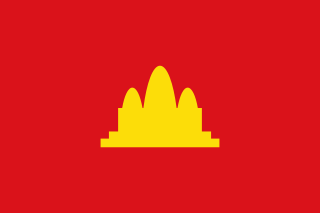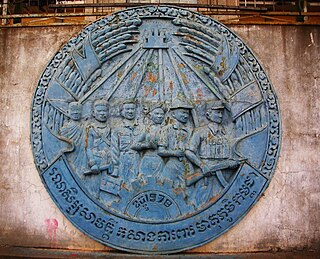
The Khmer Rouge was the name popularly given to the followers of the Communist Party of Kampuchea (CPK) and by extension to the regime through which the CPK ruled in Cambodia between 1975 and 1979. The name had originally been used in the 1950s by Norodom Sihanouk as a blanket term for the Cambodian left.

Ta Mok was a Cambodian military chief and soldier who was a senior figure in the Khmer Rouge and the leader of the national army of Democratic Kampuchea.. He was best known as "Brother Number Five" or "the Butcher". He was captured along the Thailand-Cambodia border in March 1999 by Cambodian government forces while on the run with a small band of followers and was held in government custody all the way to his death in 2006 while awaiting his war crime trial.
The Khmer Rouge period refers to the rule of Pol Pot, Nuon Chea, Ieng Sary, Son Sen, Khieu Samphan and the Communist Party of Kampuchea over Cambodia, which the Khmer Rouge renamed Democratic Kampuchea.

Son Sen, alias Comrade Khieu (សមមិត្តខៀវ), was a Cambodian Communist politician and soldier. A member of the Central Committee of the Communist Party of Kampuchea/Party of Democratic Kampuchea, the Khmer Rouge, from 1974 to 1992, Sen oversaw the Party's security apparatus, including the Santebal secret police and the notorious security prison S-21 at Tuol Sleng.

The Cambodian–Vietnamese War, otherwise known in Vietnam as the Counter-offensive on the Southwestern border, was an armed conflict between the Socialist Republic of Vietnam and Democratic Kampuchea. The war began with isolated clashes along the land and maritime boundaries of Vietnam and Kampuchea between 1975 and 1978, occasionally involving division-sized military formations. On 25 December 1978, Vietnam launched a full-scale invasion of Kampuchea and subsequently occupied the country and removed the Communist Party of Kampuchea government from power.

Nuon Chea, also known as Long Bunruot or Rungloet Laodi, is a Cambodian former politician who was the chief ideologist of the Khmer Rouge. He also served as the Prime Minister of Democratic Kampuchea.
Benedict F. Kiernan is an American academic and historian who is the Whitney Griswold Professor of History, Professor of International and Area Studies and Director of the Genocide Studies Program at Yale University.

Phnom Malai is a mountain area in Malai District, Banteay Meanchey Province of Cambodia. The district became a Khmer Rouge stronghold and battleground through the 1980s and 1990s. Today it is a remote and sparsely populated border area with scattered settlements mostly made up of former rebels.
Samdech Preah Agga Mahā Sangharājādhipati Tep Vong is a Cambodian Buddhist monk, currently the Great Supreme Patriarch of Cambodia, known for his role in re-establishing the Cambodian monkhood after the Pol Pot period and for his links to dominant political leaders since the 1980s.

The Kampuchea United Front for National Salvation, often simply referred to as Salvation Front or by its French acronym FUNSK, was the nucleus of a new Cambodian regime that would topple the Khmer Rouge and later establish the People's Republic of Kampuchea (PRK).
The People's Revolutionary Tribunal was a tribunal established by the People's Republic of Kampuchea in 1979 to try the Khmer Rouge leaders Pol Pot and Ieng Sary in absentia for genocide.
The K5 Plan, K5 Belt or K5 Project, also known as the Bamboo Curtain, was an attempt between 1985 and 1989 by the government of the People's Republic of Kampuchea to seal Khmer Rouge guerrilla infiltration routes into Cambodia by means of trenches, wire fences, and minefields along virtually the entire Thai–Cambodian border.

General elections were held in Cambodia on 1 May 1981 and marked the establishment of the new, Vietnamese-backed, state of the People's Republic of Kampuchea (PRK). The Kampuchean People's Revolutionary Party was the only party to contest the election, and won all 117 seats. Voter turnout was reported to be 90%.

The Communist Party of Kampuchea, also known as Khmer Communist Party (KCP), was a communist party in Cambodia. Its leader was Pol Pot and its followers were generally known as Khmer Rouge. The party was underground for most of its existence and took power in the country in 1975 and established the state known as Democratic Kampuchea. The party lost power in 1979 with the establishment of the People's Republic of Kampuchea by leftists who were dissatisfied by the Pol Pot regime and by the intervention of Vietnamese military forces after a period of mass killing. The party was officially dissolved in 1981, with the Party of Democratic Kampuchea claiming its legacy.
There are allegations that the United States (U.S.) supported the Khmer Rouge during the Cambodian–Vietnamese War in order to weaken the influence of Vietnam and the Soviet Union in Southeast Asia. Details of alleged U.S. actions that benefited the Khmer Rouge range from tolerating Chinese and Thai aid to the organization to directly arming the Khmer Rouge. The U.S. government officially denies these claims, and Nate Thayer defended U.S. policy, arguing that little, if any, American aid actually reached the Khmer Rouge. However, it is not disputed that the U.S. voted for the Khmer Rouge and the Coalition Government of Democratic Kampuchea (CGDK), which was dominated by the Khmer Rouge, to retain Cambodia's United Nations (UN) seat until 1982 and 1991, respectively. Furthermore, an investigation by the United States Department of State acknowledged that U.S. material support for the Khmer Rouge's CGDK partners indirectly benefited the Khmer Rouge.



















